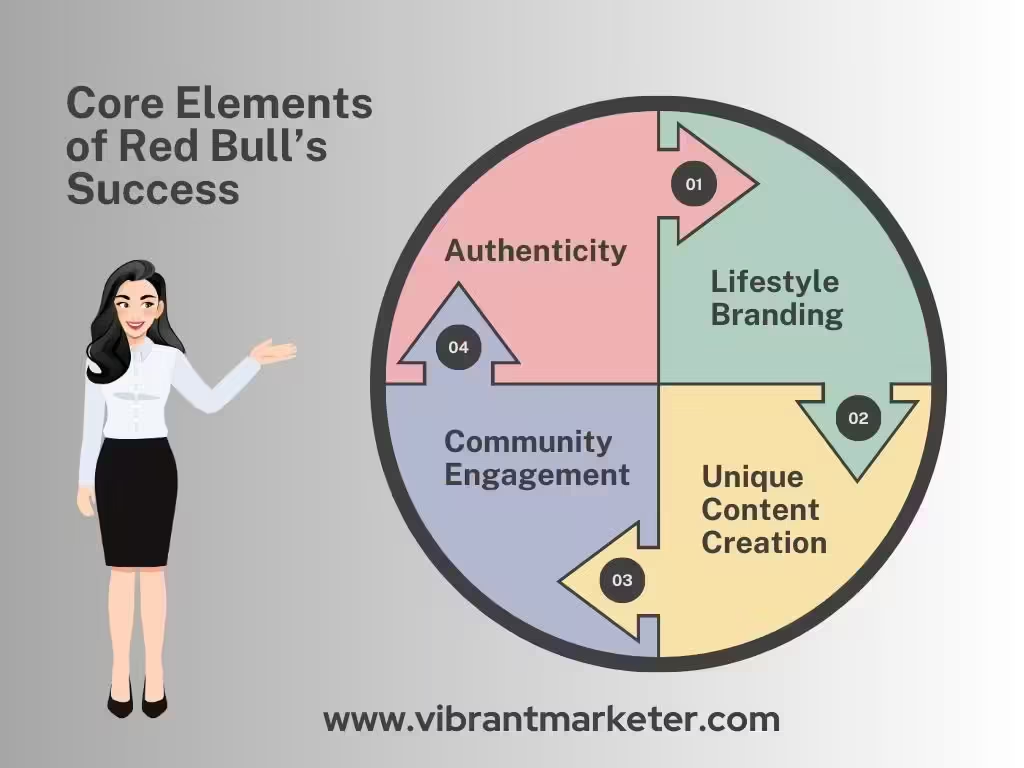
Case Study on Red Bull
Case Study on Red Bull’s Extreme Sports Marketing – Powering the World Through Adventure

The Birth of a New Category
The company’s strategy was clear: Red Bull was not just selling a drink, it was selling a lifestyle—one that resonated with thrill-seekers, athletes, and adventurers.
The Strategic Shift: From Traditional Marketing to Extreme Sports
While traditional marketing focuses on advertising and sponsorship, Red Bull took a completely different route. The brand immersed itself in the world of extreme sports, blurring the lines between sponsor and participant. Red Bull didn’t just sponsor events—it created its own. The Red Bull X-Fighters, Red Bull Rampage, and Red Bull Air Race are just a few examples of events owned, operated, and branded by the company.
- Red Bull X-Fighters: A world-renowned freestyle motocross competition.
- Red Bull Rampage: A high-stakes mountain biking event, held in Utah’s rugged desert.
- Red Bull Air Race: A series of air races where pilots navigate a challenging obstacle course at breathtaking speeds.
These events reflect Red Bull’s core values: risk-taking, adventure, and high-performance, qualities that resonate with its target audience.
Adventure and Content Creation: The Ultimate Media House
In the world of marketing, Red Bull made an unprecedented move by becoming a media company. They didn’t rely on traditional media outlets but instead created Red Bull Media House, producing its own content ranging from magazines, videos, films, and social media content. With more than 12 million subscribers on YouTube and videos garnering millions of views, the brand has successfully tapped into digital platforms, engaging with audiences directly.
One of the standout moments of Red Bull’s content creation was the Red Bull Stratos mission, where Austrian skydiver Felix Baumgartner jumped from the stratosphere, breaking the sound barrier in the process. The event was watched live by 8 million people, setting a YouTube record for the most-watched live stream at the time.
The impact was huge:
- +35% boost in sales post-event.
- Over 500 million total views across platforms in the following weeks.
- International news coverage, turning it into one of the most successful marketing events in history.
The Impact of Red Bull’s Extreme Sports Strategy

Here’s a snapshot of the key metrics and outcomes tied to Red Bull’s extreme sports involvement:
- Global Sales: Red Bull sold 11.582 billion cans in 2022, a significant growth over previous years.
- Revenue: The company’s revenue in 2022 was 9.684 billion euros.
- Sponsorship and Events: Red Bull sponsors 500+ athletes across various extreme sports disciplines and has created 100+ branded events.
- Digital Footprint: Red Bull has over 50 million followers across its social media platforms, making it one of the most digitally engaged brands in the world.
- Brand Awareness: Red Bull’s brand awareness is above 90% in key markets such as Europe and North America.
- Market Share: Red Bull holds 43% of the global energy drink market, significantly ahead of competitors like Monster and Rockstar.
Why It Works: Core Elements of Red Bull’s Success

- Lifestyle Branding: Red Bull doesn’t sell its drink as just an energy boost; it positions itself as a way of life for those who live on the edge. This has built a fiercely loyal customer base.
- Unique Content Creation: By creating its own content, Red Bull has full control over its narrative. This keeps the brand relevant and continuously in the public eye, especially with younger, digital-native audiences.
- Community Engagement: Red Bull is not just a sponsor; it’s a creator of communities. Whether it’s cliff diving, snowboarding, or street racing, the brand has built a community of athletes and fans who embody the same sense of adventure.
- Authenticity: Red Bull doesn’t just slap its logo on events. It fully immerses itself in the extreme sports culture, lending authenticity to its marketing efforts. When people think of extreme sports, they think of Red Bull.
Challenges and Adaptation
- Competition: With energy drink giants like Monster and Rockstar continuously growing, Red Bull has had to maintain its innovative edge.
- Safety Concerns: Extreme sports are inherently risky, and Red Bull’s association with dangerous stunts has occasionally drawn criticism. The brand has mitigated this by promoting safety and thorough planning for its athletes and events.
In response, Red Bull has adapted by expanding its presence in esports, combining its existing “extreme” branding with the rapidly growing gaming industry. The company has sponsored esports tournaments and gaming influencers, appealing to a new audience segment.
Conclusion: How Red Bull became a lifestyle brand
What sets Red Bull apart is its ability to be more than just a brand sponsor—it becomes an integral part of the experiences it creates. By owning the narrative around extreme sports, Red Bull ensures that its image is always one of excitement, adventure, and pushing limits.
In the end, Red Bull has shown that marketing is not just about selling a product. It’s about selling a feeling, a lifestyle, and a sense of belonging to something greater—something daring, thrilling, and absolutely unique.






